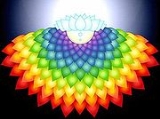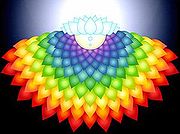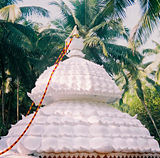
Sahasrara
Encyclopedia

Chakra
Chakra is a concept originating in Hindu texts, featured in tantric and yogic traditions of Hinduism and Buddhism. Its name derives from the Sanskrit word for "wheel" or "turning" .Chakra is a concept referring to wheel-like vortices...
according to Hindu
Hindu
Hindu refers to an identity associated with the philosophical, religious and cultural systems that are indigenous to the Indian subcontinent. As used in the Constitution of India, the word "Hindu" is also attributed to all persons professing any Indian religion...
tradition.
Location
Sahasrara is either located at the top of the head in that one area, or a little way above it (see Sahasrara system of minor chakras below).Appearance
Sahasrara is described with 1,000 multi-coloured petals which are arranged in 20 layers each of them with 50 petals. The pericarp is golden, and inside of it is a circular moon region, inside of which is a downward pointing triangle.Function
Sahasrara chakra symbolizes detachment from illusion; an essential element in obtaining supramental higher consciousnessHigher consciousness
Higher consciousness, also called super consciousness , objective consciousness , Buddhic consciousness , cosmic consciousness, God-consciousness and Christ consciousness , are expressions used in various spiritual traditions to denote the consciousness of a human being who has reached a...
of the truth that one is all and all is one.
Often referred as thousand-petaled lotus, it is said to be the most subtle chakra in the system, relating to pure consciousness, and it is from this chakra that all the other chakras emanate. When a yogi is able to raise his or her kundalini
Kundalini
Kundalini literally means coiled. In yoga, a "corporeal energy" - an unconscious, instinctive or libidinal force or Shakti, lies coiled at the base of the spine. It is envisioned either as a goddess or else as a sleeping serpent, hence a number of English renderings of the term such as 'serpent...
, energy of consciousness, up to this point, the state of Samādhi
Samadhi
Samadhi in Hinduism, Buddhism,Jainism, Sikhism and yogic schools is a higher level of concentrated meditation, or dhyāna. In the yoga tradition, it is the eighth and final limb identified in the Yoga Sūtras of Patañjali....
, or union with God, is experienced.
Meditating on this point is said to bring about the siddhis, or occult powers, of transforming into the divine, and being able to do whatever one wishes.
Sahasrara system of minor chakras
In some schemes of chakras, there are actually several chakras that are all closely related at the top of the head. Rising from AjnaAjna
Ajna is the sixth primary chakra according to Hindu tradition.-Location:The Ajna chakra is positioned in the brain, directly behind the eyebrow centre, while its ksehtram or superficial activation site is at the eyebrow region, in the position of the 'third eye'.-Appearance:Ajna is white in...
, we have the Manas chakra on the forehead, which is closely associated with Ajna. Above Manas there are Bindu Visarga at the back of the head, Mahanada, Nirvana, which is located on the crown, Guru, and then Sahasrara proper, located above the crown.
Bindu Visarga
Bindu Visarga is located at the back of the head, in a place where many Brahmins keep a tuft of hair. It is symbolised by a crescent moon on a moonlit night, with a point or bindu above it. This is the white bindu, with which yogis try to unite the red bindu below, and it is the source of the divine nectar or amrit which falls down to vishuddhi for distribution throughout the entire bodily system. This white drop is considered the essence of sperm, while the red bindu is considered the essence of the menstrual fluid.This chakra is sometimes known as the Indu, Chandra or Soma chakra. In other descriptions, it is located on the forehead, white, with 16 petals, corresponding to the vrittis of mercy, gentleness, patience, non-attachment, control, excellent- qualities, joyous mood, deep spiritual love, humility, reflection, restfulness, seriousness, effort, controlled emotion, magnanimity and concentration.
Mahanada
The name of this chakra is 'Great sound', and it is in the shape of a plough. It represents the primal sound from which emanates all of creation.Nirvana
This chakra is located on the crown of the head. It is white in colour and possesses 100 white petals. It marks the end of the sushumna central channel. It is responsible for different levels of concentration, dharanaDharana
Dhāraṇā is translated as "collection or concentration of the mind ", or "the act of holding, bearing, wearing, supporting, maintaining, retaining, keeping back , a good memory", or "firmness, steadfastness, ... , certainty"...
, dhyana
Dhyana in Hinduism
According to the Hindu Yoga Sutra, written by Patanjali, dhyana is one of the eight limbs of Yoga, ....
and savikalpa
Savikalpa
Savikalpa-samādhi is one of the highest forms of minor state of samadhi. In Savikalpa samadhi, the human consciousness is dissolved and lost for a short period of time...
samadhi
Samadhi
Samadhi in Hinduism, Buddhism,Jainism, Sikhism and yogic schools is a higher level of concentrated meditation, or dhyāna. In the yoga tradition, it is the eighth and final limb identified in the Yoga Sūtras of Patañjali....
.
Guru
The guru chakra is located above the head, just below Sahasrara proper. It is white, with 12 white petals, upon which is written the guru mantra, Ha Sa Kha Freng Ha Sa Ksha Ma La Wa Ra Yung. It contains a circular moon region, within which is a downward pointing triangle containing a jewelled altar with the crescent moon below and circular bindu above. Inside the bindu is the seat, upon which are the gurus footstools, upon which are the Gurus feet.This position is considered very important in Tibetan Tantric practices of deity yoga, where the guru or deity is often visualised above the crown, and then bestowing blessings below (for example in the Vajrasattva
Vajrasattva
Vajrasattva is a bodhisattva in the Mahayana, Mantrayana and Vajrayana buddhist traditions...
purification meditation).
Higher levels
Within Sahasrara, there are yet more levels of subtlety. Within the triangle begin a series of ever higher levels of consciousness; ama-kala, the first ring of visarga, nirvana-kala, nirvana shakti, which contains the second ring of visarga. From here, kundalini becomes shankhini, with 3 and a half coils. The first coil of shankhini wraps around supreme bindu, the second coil of shankhini wraps around the supreme nada, the third coil of shankhini wraps around shakti, and the half-coil of shankhini enters into sakala shiva, beyond which is parama shiva.Visarga
This is symbolised by two dots, one of which is inside ama-kala, and the other of which is below supreme bindu, which represents the transition from samprajnata samadhi to the oneness of asamprajnata samadhi.Nirvana-kala
Here kundalini absorbs even the experience of samadhi, through the power of supreme control (nirodhika fire).Nirvana-shakti
Here kundalini passes into the supreme void, which is the experience of asamprajnata or nirvikalpaNirvikalpa
Nirvikalpa is a Sanskrit adjective with the general sense of "not admitting an alternative", formed by applying the contra-existential prepositional prefix to the term .-Usage:...
samadhi, and becomes shankhini. Kundalini then wraps around and absorbs the supreme bindu, which is the void, the supreme nada, and shakti, and then unites with and absorbs shiva, before finally being absorbed into paramashiva, which is the final stage of nirvikalpa samadhi.
Association with the body
Sahasrara is related to the crown of the head. It is sometimes related to the pineal glandPineal gland
The pineal gland is a small endocrine gland in the vertebrate brain. It produces the serotonin derivative melatonin, a hormone that affects the modulation of wake/sleep patterns and seasonal functions...
and sometimes to the pituitary gland
Pituitary gland
In vertebrate anatomy the pituitary gland, or hypophysis, is an endocrine gland about the size of a pea and weighing 0.5 g , in humans. It is a protrusion off the bottom of the hypothalamus at the base of the brain, and rests in a small, bony cavity covered by a dural fold...
.
Comparisons with other systems
The crown wheel is important within the Highest Yoga traditions of Buddhist Vajrayana. It is triangular, with 32 petals or channels that point downwards, and within it resides the white drop or white bodhicitta. Through meditation, the yogi attempts to unite this drop with the red bodhicitta in the navel, and to experience the union of emptiness and bliss.It is very important in the Tantric practice of Phowa, or consciousness transference. At the time of death, a yogi can direct his consciousness up the central channel and out of this wheel in order to be reborn in a Pure Land, where they can carry on their tantric practices, or they can transfer their consciousness into another body or a corpse, in order to extend their lives.

Tree of life
The concept of a tree of life, a many-branched tree illustrating the idea that all life on earth is related, has been used in science , religion, philosophy, mythology, and other areas...
, which also rests at the head of the tree, and represents pure consciousness and union with God.
Within the Sufi system of Lataif-e-sitta
Lataif-e-sitta
Lataif-as-Sitta are psychospiritual "organs" or, sometimes, faculties of sensory and suprasensory perception in Sufi psychology. They are thought to be parts of the self in a similar manner to the way glands and organs are part of the body...
there is a Lataif called Akfha, the 'most arcane subtlety', which is located on the crown. It is the point of unity where beatific visions of Allah are directly revealed.
Alternative names
- In TantraTantraTantra , anglicised tantricism or tantrism or tantram, is the name scholars give to an inter-religious spiritual movement that arose in medieval India, expressed in scriptures ....
: Adhomukha MahapadmaMahapadmaMahāpadma may refer to*a legendary Karma sutra in Hindu mythology**one of the nine treasures of Longarm**a particular treasure inhabited by a N%C4%81ga, and a name of that Naga**one of the eight treasures connected with Padmini magic...
, Amlana Padma, Dashashatadala Padma, Pankaja, Sahasrabja, Sahasrachchada Panikaja, Sahasradala, Sahasradala Adhomukha Padma, Sahasradala Padma, Sahasrapatra, Sahasrara, Sahasrara Ambuja, Sahasrara Mahapadma, Sahasrara Padma, Sahasrara Saroruha, Shiras Padma, Shuddha Padma, Wyoma, Wyomambhoja - In the VedasVedasThe Vedas are a large body of texts originating in ancient India. Composed in Vedic Sanskrit, the texts constitute the oldest layer of Sanskrit literature and the oldest scriptures of Hinduism....
and late UpanishadUpanishadThe Upanishads are philosophical texts considered to be an early source of Hindu religion. More than 200 are known, of which the first dozen or so, the oldest and most important, are variously referred to as the principal, main or old Upanishads...
s: AkashaAkashaAkasha is the Sanskrit word meaning "aether" in both its elemental and metaphysical senses.-Hinduism:...
Chakra, Kapalasamputa, Sahasradala, Sahasrara, Sahasrara Kamala (Pankaja or Padma), Sthana, WyomaWyomaWyoma are a genus of insect, belonging to the family Tineidae....
, Wyomambuja - In the PuranasPuranasThe Puranas are a genre of important Hindu, Jain and Buddhist religious texts, notably consisting of narratives of the history of the universe from creation to destruction, genealogies of kings, heroes, sages, and demigods, and descriptions of Hindu cosmology, philosophy, and geography.Puranas...
: ParamaParamaParama is a village in the administrative district of Gmina Tomaszów Lubelski, within Tomaszów Lubelski County, Lublin Voivodeship, in eastern Poland....
, Sahasradala, Sahasraparna Padma, Sahasrapatra, Sahasrara, Sahasrara Kamala (Parikaja or Padma), Shantyatita, Shantyatita Pada - In the Agni YogaAgni YogaLiving Ethics has also another equivalent but less widespread meaning Agni Yoga — a philosophical and ethical teaching which embraces all sides of being — from cosmological problems, down to daily human life...
teaching, the Brahmarandhra is often referred to as "the bell" (Russian: колокол).

